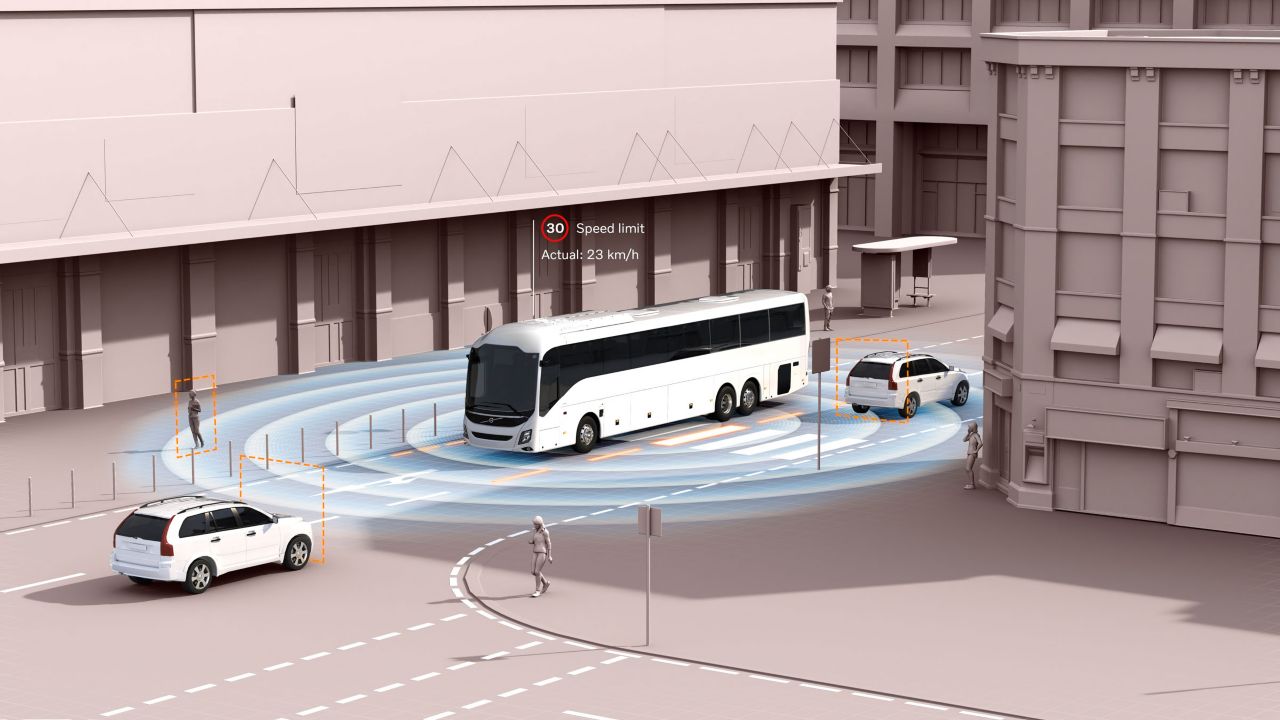London is set to debut a major public transport safety innovation later this year in real traffic, as the first Volvo BZL Electric buses equipped with City Brake — a new form of Advanced Emergency Braking (AEB) — hit the city’s streets.
The move supports Transport for London (TfL) and Mayor Sadiq Khan’s ambitious Vision Zero goal to eliminate all fatalities and serious injuries on the capital’s roads by 2041, with an additional interim target of zero deaths involving buses by 2030.
Rachel Birrell, Bus Safety Development Manager at TfL, explains: “Our Vision Zero approach demonstrates the importance of ensuring a safe bus network for everyone, and shows the influence TfL has to drive new standards of bus safety.
“Our approach follows the principle that mistakes happen, and the transport system needs to accommodate human error and unpredictability, and that those with a role in designing, building, operating, managing and using our streets have a responsibility to reduce road danger.”
A roadmap for better bus safety
Key to achieving these ambitious targets is TfL’s Bus Safety Standard, published in 2018. The publication sets out a series of additional safety requirements for new vehicles joining TfL’s network, the first of which were introduced in 2019.
The latest of these safety features is AEB, a system already used on trucks, coaches and even in cars. Until now, it has not been offered on buses, given the complexities for a vehicle carrying both unrestrained seated and standing passengers.
Thomas Forsberg, Head of Safety at Volvo Buses, says: “We launched our first AEB system back in 2015 for coaches and it has continuously been developed and improved, taking us closer to our vision of Zero Accidents. Now we are taking another step, further enhancing safety for vulnerable road users and vehicle occupants by introducing AEB in our city segment, Class I and Class II vehicles – a solution we’ve called City Brake.
“Fine-tuning this system for city traffic was a complex process, as we had to calibrate it to take account of both lower speeds, and the fact that passengers would likely either be seated without a seatbelt, standing, or possibly moving around the vehicle. Analysis also found that in most pedestrian collisions involving a bus in London, the time to collision was less than two seconds, which means our technology has a very narrow window in which to react.”
Extensive research drives new safety feature deployment
Explaining the process which led to AEB’s introduction, Rachel Birrell says: “I'm passionate about improving the safety of our bus network, so this has been a dream project for me.
“We've worked closely with all bus manufacturers and their suppliers in the development of the specification for AEB, and in sharing our extensive research and analysis. This saw us commission the Transport Research Laboratory (TRL) and Apollo Vehicle Safety to complete a detailed bus braking analysis in 2022.”
The team studied more than 1,000,000 km of bus journeys from 50 vehicles in London, each fitted with an advanced telematics system that logged braking applications during service. This process helped a panel of experts to better understand the potential risk to bus passengers, and informed TfL’s precise specification and testing protocols around AEB.
TfL is confident that the solution it has arrived at with manufacturers, including Volvo, is an important part of the Bus Safety Standard with its research showing it has the potential to prevent up to around 25 per cent of pedestrian fatalities from collisions involving buses. AEB will also help protect passengers onboard who may otherwise have been injured as the result of a collision.
Detailed passenger analysis
The Bus Braking Data Analysis found that the potential risk of injuries to those onboard from false positive activations of AEB was much lower than found in previous research. Occupants were also at significantly lower risk from heavy braking events than previously predicted.
“We will be monitoring the performance of the system closely to ensure the balance of benefits for road users and bus passengers outweighs any potential disbenefit to bus passengers, and that risk is mitigated as far as possible.”
Deployment of AEB to commence this autumn
Looking ahead, what will be the impact in London and beyond?
Rachel Birrell explains: “Our Bus Safety Standard goes above and beyond regulation, making sure that buses meet the highest possible safety standards. At TfL, we're keen for operators and transport authorities outside London to also benefit and I’m delighted to say there are other cities that are adopting or aligning with what we’ve done, including Transport for Greater Manchester and Translink in Northern Ireland.
“We're always keen to share our research and development, so that more fleets can benefit. And that isn’t confined to the UK, either. Volvo Buses and others will be actively looking to take their respective solutions, and deploy them in markets around the world, for the widest possible benefit.”
When the first City Brake-equipped Volvo BZL Electric buses enter service on TfL routes later this year, the system will initially operate in ‘shadow mode’, to enable TfL to fully understand how the system functions under its bus vehicle specification and testing protocol, but without the emergency braking function being activated.
Rachel Birrell concludes: “We'll be reviewing all the data and insights we compile and working very closely with Volvo, and all bus manufacturers, before we sign the system off to go live in London. By working closely with the industry we’ve already made significant progress, and it’s going to be exciting to get the shadow mode testing underway, ahead of a full roll-out of AEB.”


